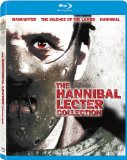| Reviews & Columns |
|
Reviews DVD TV on DVD Blu-ray 4K UHD International DVDs In Theaters Reviews by Studio Video Games Features Collector Series DVDs Easter Egg Database Interviews DVD Talk Radio Feature Articles Columns Anime Talk DVD Savant Horror DVDs The M.O.D. Squad Art House HD Talk Silent DVD
|
DVD Talk Forum |
|
|
| Resources |
|
DVD Price Search Customer Service #'s RCE Info Links |
|
Columns
|
|
|
Manhunter: Hannibal Lecter Collection
MGM // R // September 15, 2009
List Price: $69.98 [Buy now and save at Amazon]
The Film:
Michael Mann's Manhunter is as an under-appreciated gem of '80s suspense, staying relevant and edgy due to a moody blend of suspense, style, and surgical filmmaking. It marks his third high-profile directorial effort (first and second being Thief and The Keep), as well as the first -- and oft-overlooked -- on-screen appearance of ole' Hannibal Lecter. Adapted from Thomas Harris' novel, "Red Dragon", we follow ex-FBI agent William Graham (William Petersen) as he's pulled out of pseudo-retirement and thrown knee-deep into a new case. His specialty lies in soaking into the mindset of a killer, mimicking his motions in crime scenes and verbalizing a conglomerated tirade of both his and his subject's thoughts. The target is the "Tooth Fairy", a man who has grown notorious for sinking his teeth into his victims -- among other horrific acts.
Though the killer's compelling eccentricities comes into the spotlight later in the film, Manhunter chiefly focuses on Will Graham's rattled psyche and he's sent bouncing all over the Southeast in his investigation. Though he's yanked out of retirement by his old colleague Jack Crawford (Dennis Farina), a recurring character in Thomas Harris' stories, he's far from the lackadaisical beach-bound family man. William Petersen, now famed as the gray-haired Gil Grissom from many different variants of CSI, gives off early flickers of the same panache in Will Graham as he soaks into a deep, recessive mental tone. Though his conversations with the police and FBI are dynamic, it's his moments alone at the crime scenes -- where he follows step-by-step, though-by-thought through the killer's brain -- that build him into a fascinating character.
Eventually, he needs a bit of a refresher course in the ways of a serial killer, which leads him to visit the violent man who sent him spiraling into retirement -- Dr. Hannibal Lecktor (yep, spelled "Lecktor" for this picture). Here is where Manhunter has earned its somewhat forgotten reputation in the "Hannibal the Cannibal" narrative, as he's played by Braveheart and Troy star Brian Cox. His take on Lecktor/Lecter is certainly different from that of Anthony Hopkins; instead of frighteningly erratic, Cox's Lecktor showcases the same intelligence in a chillier, more methodical fashion. All three of his scenes linger throughout the film, especially after the first encounter when Will Graham bolts out of the room and weaving down the stairs of the high-security mental hospital (which, interestingly, happens to be the echoic stairwell in the High Museum of Art in Atlanta).
As the tension swells and we ease towards the killer's location, Manhunter takes the less-obvious route by latching onto Michael Mann's insatiable eye for intimate human interaction. "Tooth Fairy" Dolarhyde might be unnerving on subtle levels, certainly with Tom Noonan's understated glances as the disquieting villain, but the true energy of the film's subtle fright comes from the interaction between Graham and the killer's raw consciousness. As Graham gets lost in his mind and verbally paints the gory murder scenes for us, it touches on the primal nature within Dolarhyde without showing us any -- well, much -- of the actual violence. Then, as we witness the "Tooth Fairy" in his day-to-day environment, we're reminded more of Graham's maddening elaborations than the grueling image of potential blood-soaked victims.
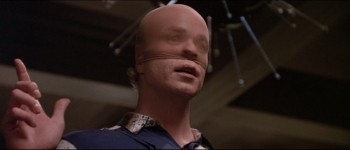 Our trepidation boils to a head in a conversation between Graham and his son as they walk down the cereal and coffee aisle in an anonymous grocery store: they discuss Graham's stint in a mental institution, a discussion where Graham delves into the root of the madness that caused him to be both physically and emotionally destroyed. Many elements crop up from their talk, from the redemption that Graham might want to exert on Lecter, as well as the very nature of his mentally investigative job. Though little more than a simple talk, it evokes a wealth of fear about the uncertainty of mental instability -- the real terrifying element in Manhunter. A raw slab of realism is thrust in our face, and we're more than captivated amid our curious dread.
Our trepidation boils to a head in a conversation between Graham and his son as they walk down the cereal and coffee aisle in an anonymous grocery store: they discuss Graham's stint in a mental institution, a discussion where Graham delves into the root of the madness that caused him to be both physically and emotionally destroyed. Many elements crop up from their talk, from the redemption that Graham might want to exert on Lecter, as well as the very nature of his mentally investigative job. Though little more than a simple talk, it evokes a wealth of fear about the uncertainty of mental instability -- the real terrifying element in Manhunter. A raw slab of realism is thrust in our face, and we're more than captivated amid our curious dread.
Manhunter, though it has the fiercest title, is the leanest and most cerebral of all the Hannibal Lecter films. It relies more on the stirring psychoses than anything we really see on-screen, even though Michael Mann gives us plenty of visual imagery to heighten the experience. While contemplating the reasoning behind Dolarhyde's sadistic motives, we watch his future victim -- a blind woman -- as she strokes a sedated tiger under heavy anesthetics. Mann's film is much like this tiger, and we're the woman sightlessly feeling the ferocity that's being kept sedated until the right moment. In all its neon-bathed "Miami Vice"-like glory, it's certainly a formidable creature.
So, Exactly Which Cut of Manhunter Is This?
With a runtime just a hair over two hours (2:00:05), this cut of Manhunter happens to be a version I haven't seen before. Both the cuts on Anchor Bay's Limited Edition DVD are a "false" theatrical version (121 minutes) and a director's cut (124 minutes) -- and MGM's cut is neither. Many will tell you that the differences are slight yet purposeful, featuring minor additions and, as is the case for this cut, a few subtractions. Based on the material that I've read about the film's distribution history, it seems as if this might be the "true" theatrical cut of the film -- but, of course, I can't be certain, since I didn't see the film in theaters. What I can do, instead, is go over the differences:
Spoiler Alert:
Several scenes have been removed from Anchor Bay's theatrical version, including the discussion Graham has with the overly-descriptive realtor before he examines the backyard (occurring at 33:52 -- 34:33 on AB's DVD) and the scene with Graham and his wife where he stares into the window with his Lecktor-incurred scar cleanly visible (52:22 -- 54:51). More importantly, a few scenes have also been added: a quick discussion with the police chief as they enter into the briefing room (18:12 -- 18:28 in MGM's Blu-ray), further elaboration on "What happened then?" during Graham discussion with the police chief about his stint with Lecktor (20:02 -- 20:20), and an excellent scene added where Graham and Crawford talk about sympathizing with the killer (1:33:31).
A few other slight aesthetic changes have also occurred. While a small amount of footage has been clipped right before Graham walks into the Birmingham victim's house during a rainy night, the big, noticeable difference comes in the delayed positioning of the narration -- making the alignment between what's going on and what's being talked about a little different, yet still aligned properly. Along with those instances, there's a scene with Hannibal Lecktor as he smoothly makes a phone call out in an effort to learn Will Graham's home address. That entire scene has been framed differently, showing more of Brian Cox's torso and much less space above his head. Finally, it's worth noting that the title cards are blue, not black. Differences between all three cuts are, as mentioned, extremely slight. However, there are a few lines of dialogue that are sorely missed from Anchor Bay's theatrical cut that are available in MGM's Blu-ray presentation.
End Spoilers
The Blu-ray:
Manhunter is currently only available on Blu-ray as part of MGM's Hannibal Lecter Collection.
Video and Audio:
Manhunter has been presented from MGM in a beefy 1080p AVC encode, one that topples over nearly 40mbps in densely contrasted scenes amid its 2.20:1 framing. From the outside looking in, this Blu-ray is a stellar rendering of stylish '80s cinematography -- flesh tones are believable, a veil of natural grain drapes over the image, and black levels are especially inky. It's very cinematic in construction, yet the amount of detail present in the image can be impressive on many accounts. Coloring looks far more natural than it does in comparison to the 2001 Anchor Bay Limited Edition, rendering a much more controlled color scheme. It looks fantastic for its age, coming together in a very pleasing manner that fits many of the film's captured in cinematographer Dante Spinotti's eye -- reflecting something of a collage between L.A. Confidential and The Insider.
However, and there's definitely a however, the coloring and contrast levels might not be accurate. We're still working with many neon-drenched sequences, but some of the coloring has been drastically controlled -- looking far more probable and less "from the period" loud. Neon greens lean towards a creamier coloring in some instances, while an actual neon pink light now shows off a nice off-white bulb instead of one befitting a lightsaber. You'll also want to take a look at the climax's night sequences, which has been drained of color. Instead, it captures a tone more expected from a nighttime sequence, with some of the glaring blues and other hues flattened nearly to slight shifts in grayscale -- though greens are mostly retained. Though impressive in many scenes, the dark black sequences sometimes get a little "too" black, drowning out details like folds in clothing and minor textures in Will Graham's grayish-black textured jacket. Still, considering the natural-minded improvements, it's a very attractive image that certainly retains the mood of the film's tension to impeccable levels.
Along with the 1080p image, we've also got a lossless DTS HD Master Audio track that does the film's sound elements proper justice. It's an extremely front-heavy track that concentrates on clear dialogue and robust scoring, which are both preserved well. Surround elements are largely reserved for expanded musical cues -- the pan flute during the tiger scene being the most prominent of them all -- which inclines one to simply see the surround track as little more than a stretched-out stereo track. Although, dialogue remains very natural and audible, though it sports the period's slight age twang. Some sound effects, like the shattering of glass and the hang-up of a phone, exhibit the same level of clarity with a slight showing of the source's age. It's actually a very good-sounding track, though low on dynamics. Spanish and French 5.1 tracks are also available, as are optional English and Spanish subtitles.
Special Features:
Unless you count a Scene Selection, then nothing. Nothing at all.
Final Thoughts:
Though sans special features, this Blu-ray presentation of Manhunter easily marks the paramount reason to snatch up the Hannibal Lecter Collection. Along with showcasing an alternate cut from those released by Anchor Bay, we've also got a beautifully rendered -- if overly natural -- visual transfer of Michael Mann's film. To say the least, Manhunter shouldn't be overlooked for any reason -- whether it be for the absence of Anthony Hopkins or the slight '80s panache. This is a very strongly Recommended presentation of a chilling, brainy thriller, and a off-kilter yet compelling beginning to the Lecter saga.
Thomas Spurlin, Staff Reviewer -- DVDTalk Reviews | Personal Blog/Site
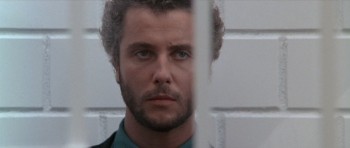 |
Though the killer's compelling eccentricities comes into the spotlight later in the film, Manhunter chiefly focuses on Will Graham's rattled psyche and he's sent bouncing all over the Southeast in his investigation. Though he's yanked out of retirement by his old colleague Jack Crawford (Dennis Farina), a recurring character in Thomas Harris' stories, he's far from the lackadaisical beach-bound family man. William Petersen, now famed as the gray-haired Gil Grissom from many different variants of CSI, gives off early flickers of the same panache in Will Graham as he soaks into a deep, recessive mental tone. Though his conversations with the police and FBI are dynamic, it's his moments alone at the crime scenes -- where he follows step-by-step, though-by-thought through the killer's brain -- that build him into a fascinating character.
Eventually, he needs a bit of a refresher course in the ways of a serial killer, which leads him to visit the violent man who sent him spiraling into retirement -- Dr. Hannibal Lecktor (yep, spelled "Lecktor" for this picture). Here is where Manhunter has earned its somewhat forgotten reputation in the "Hannibal the Cannibal" narrative, as he's played by Braveheart and Troy star Brian Cox. His take on Lecktor/Lecter is certainly different from that of Anthony Hopkins; instead of frighteningly erratic, Cox's Lecktor showcases the same intelligence in a chillier, more methodical fashion. All three of his scenes linger throughout the film, especially after the first encounter when Will Graham bolts out of the room and weaving down the stairs of the high-security mental hospital (which, interestingly, happens to be the echoic stairwell in the High Museum of Art in Atlanta).
As the tension swells and we ease towards the killer's location, Manhunter takes the less-obvious route by latching onto Michael Mann's insatiable eye for intimate human interaction. "Tooth Fairy" Dolarhyde might be unnerving on subtle levels, certainly with Tom Noonan's understated glances as the disquieting villain, but the true energy of the film's subtle fright comes from the interaction between Graham and the killer's raw consciousness. As Graham gets lost in his mind and verbally paints the gory murder scenes for us, it touches on the primal nature within Dolarhyde without showing us any -- well, much -- of the actual violence. Then, as we witness the "Tooth Fairy" in his day-to-day environment, we're reminded more of Graham's maddening elaborations than the grueling image of potential blood-soaked victims.
 Our trepidation boils to a head in a conversation between Graham and his son as they walk down the cereal and coffee aisle in an anonymous grocery store: they discuss Graham's stint in a mental institution, a discussion where Graham delves into the root of the madness that caused him to be both physically and emotionally destroyed. Many elements crop up from their talk, from the redemption that Graham might want to exert on Lecter, as well as the very nature of his mentally investigative job. Though little more than a simple talk, it evokes a wealth of fear about the uncertainty of mental instability -- the real terrifying element in Manhunter. A raw slab of realism is thrust in our face, and we're more than captivated amid our curious dread.
Our trepidation boils to a head in a conversation between Graham and his son as they walk down the cereal and coffee aisle in an anonymous grocery store: they discuss Graham's stint in a mental institution, a discussion where Graham delves into the root of the madness that caused him to be both physically and emotionally destroyed. Many elements crop up from their talk, from the redemption that Graham might want to exert on Lecter, as well as the very nature of his mentally investigative job. Though little more than a simple talk, it evokes a wealth of fear about the uncertainty of mental instability -- the real terrifying element in Manhunter. A raw slab of realism is thrust in our face, and we're more than captivated amid our curious dread. Manhunter, though it has the fiercest title, is the leanest and most cerebral of all the Hannibal Lecter films. It relies more on the stirring psychoses than anything we really see on-screen, even though Michael Mann gives us plenty of visual imagery to heighten the experience. While contemplating the reasoning behind Dolarhyde's sadistic motives, we watch his future victim -- a blind woman -- as she strokes a sedated tiger under heavy anesthetics. Mann's film is much like this tiger, and we're the woman sightlessly feeling the ferocity that's being kept sedated until the right moment. In all its neon-bathed "Miami Vice"-like glory, it's certainly a formidable creature.
So, Exactly Which Cut of Manhunter Is This?
With a runtime just a hair over two hours (2:00:05), this cut of Manhunter happens to be a version I haven't seen before. Both the cuts on Anchor Bay's Limited Edition DVD are a "false" theatrical version (121 minutes) and a director's cut (124 minutes) -- and MGM's cut is neither. Many will tell you that the differences are slight yet purposeful, featuring minor additions and, as is the case for this cut, a few subtractions. Based on the material that I've read about the film's distribution history, it seems as if this might be the "true" theatrical cut of the film -- but, of course, I can't be certain, since I didn't see the film in theaters. What I can do, instead, is go over the differences:
Spoiler Alert:
Several scenes have been removed from Anchor Bay's theatrical version, including the discussion Graham has with the overly-descriptive realtor before he examines the backyard (occurring at 33:52 -- 34:33 on AB's DVD) and the scene with Graham and his wife where he stares into the window with his Lecktor-incurred scar cleanly visible (52:22 -- 54:51). More importantly, a few scenes have also been added: a quick discussion with the police chief as they enter into the briefing room (18:12 -- 18:28 in MGM's Blu-ray), further elaboration on "What happened then?" during Graham discussion with the police chief about his stint with Lecktor (20:02 -- 20:20), and an excellent scene added where Graham and Crawford talk about sympathizing with the killer (1:33:31).
A few other slight aesthetic changes have also occurred. While a small amount of footage has been clipped right before Graham walks into the Birmingham victim's house during a rainy night, the big, noticeable difference comes in the delayed positioning of the narration -- making the alignment between what's going on and what's being talked about a little different, yet still aligned properly. Along with those instances, there's a scene with Hannibal Lecktor as he smoothly makes a phone call out in an effort to learn Will Graham's home address. That entire scene has been framed differently, showing more of Brian Cox's torso and much less space above his head. Finally, it's worth noting that the title cards are blue, not black. Differences between all three cuts are, as mentioned, extremely slight. However, there are a few lines of dialogue that are sorely missed from Anchor Bay's theatrical cut that are available in MGM's Blu-ray presentation.
End Spoilers
The Blu-ray:
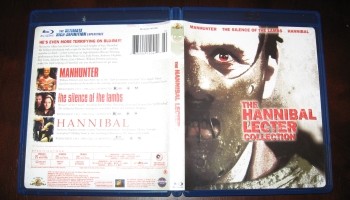 | 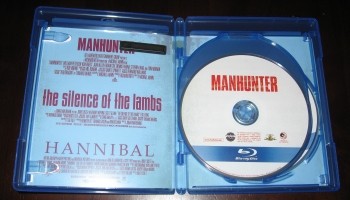 |
Video and Audio:
Manhunter has been presented from MGM in a beefy 1080p AVC encode, one that topples over nearly 40mbps in densely contrasted scenes amid its 2.20:1 framing. From the outside looking in, this Blu-ray is a stellar rendering of stylish '80s cinematography -- flesh tones are believable, a veil of natural grain drapes over the image, and black levels are especially inky. It's very cinematic in construction, yet the amount of detail present in the image can be impressive on many accounts. Coloring looks far more natural than it does in comparison to the 2001 Anchor Bay Limited Edition, rendering a much more controlled color scheme. It looks fantastic for its age, coming together in a very pleasing manner that fits many of the film's captured in cinematographer Dante Spinotti's eye -- reflecting something of a collage between L.A. Confidential and The Insider.
However, and there's definitely a however, the coloring and contrast levels might not be accurate. We're still working with many neon-drenched sequences, but some of the coloring has been drastically controlled -- looking far more probable and less "from the period" loud. Neon greens lean towards a creamier coloring in some instances, while an actual neon pink light now shows off a nice off-white bulb instead of one befitting a lightsaber. You'll also want to take a look at the climax's night sequences, which has been drained of color. Instead, it captures a tone more expected from a nighttime sequence, with some of the glaring blues and other hues flattened nearly to slight shifts in grayscale -- though greens are mostly retained. Though impressive in many scenes, the dark black sequences sometimes get a little "too" black, drowning out details like folds in clothing and minor textures in Will Graham's grayish-black textured jacket. Still, considering the natural-minded improvements, it's a very attractive image that certainly retains the mood of the film's tension to impeccable levels.
Along with the 1080p image, we've also got a lossless DTS HD Master Audio track that does the film's sound elements proper justice. It's an extremely front-heavy track that concentrates on clear dialogue and robust scoring, which are both preserved well. Surround elements are largely reserved for expanded musical cues -- the pan flute during the tiger scene being the most prominent of them all -- which inclines one to simply see the surround track as little more than a stretched-out stereo track. Although, dialogue remains very natural and audible, though it sports the period's slight age twang. Some sound effects, like the shattering of glass and the hang-up of a phone, exhibit the same level of clarity with a slight showing of the source's age. It's actually a very good-sounding track, though low on dynamics. Spanish and French 5.1 tracks are also available, as are optional English and Spanish subtitles.
Special Features:
Unless you count a Scene Selection, then nothing. Nothing at all.
Final Thoughts:
Though sans special features, this Blu-ray presentation of Manhunter easily marks the paramount reason to snatch up the Hannibal Lecter Collection. Along with showcasing an alternate cut from those released by Anchor Bay, we've also got a beautifully rendered -- if overly natural -- visual transfer of Michael Mann's film. To say the least, Manhunter shouldn't be overlooked for any reason -- whether it be for the absence of Anthony Hopkins or the slight '80s panache. This is a very strongly Recommended presentation of a chilling, brainy thriller, and a off-kilter yet compelling beginning to the Lecter saga.
|
| Popular Reviews |
| Sponsored Links |
|
|
| Sponsored Links |
|
|
| Release List | Reviews | Shop | Newsletter | Forum | DVD Giveaways | Blu-Ray | Advertise |
|
Copyright 2024 DVDTalk.com All Rights Reserved. Legal Info, Privacy Policy, Terms of Use,
Manage Preferences,
Your Privacy Choices | |||||||









